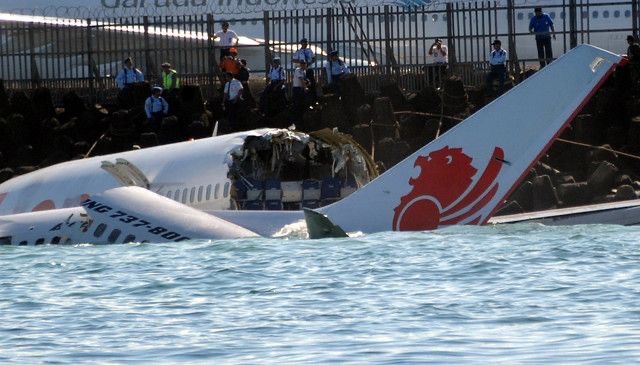
Indonesian authorities have launched an investigation into the crash of a Lion Air passenger jet that went down off the coast of Bali on Monday morning, raising fresh concerns about aviation safety in the region. The Boeing 737-800, operating as Lion Air Flight JT892 from Surabaya to Denpasar, overshot the runway during landing at Ngurah Rai International Airport and plunged into shallow waters just beyond the tarmac.
The aircraft broke apart upon impact, with its fuselage resting partially submerged in the sea. Eyewitnesses reported seeing smoke and debris as rescuers rushed to the scene. According to the National Search and Rescue Agency (Basarnas), all 189 passengers and crew members have been accounted for. While there were no fatalities, at least 40 people sustained injuries ranging from fractures to minor cuts and bruises. Most were evacuated to nearby hospitals in Denpasar.
Initial reports suggest that the aircraft encountered heavy rain and strong crosswinds while attempting to land. Flight data from air traffic control shows that the jet had been cleared for approach but may have come in too low and too fast before touching down. The pilots, both Indonesian nationals with over a decade of combined experience, are said to have attempted a go-around before the aircraft hit the water.
Indonesia’s National Transportation Safety Committee (KNKT) has begun collecting evidence from the crash site, including flight data recorders—commonly known as the black boxes—which divers retrieved late Monday evening. Investigators said their primary focus is determining whether weather, mechanical failure, or pilot error contributed to the accident. Representatives from Boeing and the U.S. National Transportation Safety Board (NTSB) are expected to assist with the probe.
Lion Air, Indonesia’s largest privately owned carrier, has come under scrutiny in the past for its safety record. The airline has experienced several incidents over the past two decades, including the 2018 crash of Lion Air Flight JT610, a Boeing 737 MAX 8 that plunged into the Java Sea shortly after takeoff from Jakarta, killing all 189 people on board. While the aircraft involved in the Bali crash is an older 737-800 model and not part of the MAX series, the latest incident has reignited public debate over maintenance standards and regulatory oversight within Indonesia’s rapidly growing aviation sector.
In a press briefing, Lion Air spokesperson Danang Mandala Prihantoro said the airline is “fully cooperating” with authorities and has grounded several aircraft of the same type for precautionary checks. “Safety is our utmost priority,” he said, adding that the company is providing support to passengers and crew members affected by the accident.
Transportation Minister Budi Karya Sumadi called for a comprehensive review of runway safety protocols at airports across the country, particularly those with challenging approaches like Bali’s seaside airstrip. “We must learn from every incident,” he said. “Our aviation safety must match the pace of our air travel growth.”
As investigators begin their work, the wreckage remains a stark reminder of the dangers faced by airlines operating in Indonesia’s volatile weather conditions and congested skies. A preliminary report is expected within 30 days, though a full investigation could take several months.


